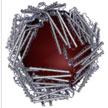This is the next stage in robotics.
This device is called a memristor.
Here are its characteristics:

The Chinese just came up with an optical one of these. It consumes virtually zero power.
What this is, is a resistor with a non volatile memory. In other words, an artificial synapse.

 spectrum.ieee.org
spectrum.ieee.org
Here's what a neural network made of memristors looks like:

But here's the really interesting part:
Memristors can be made from proteins.

Variations of ferritin seem to work exceedingly well
This discovery has led to an explosion of research in neuroscience, to understand how long term memory is retained at the synaptic level.
A synapse turns out to be very complicated. Little bits of RNA travel from the cell body to the synapse via microtubules, where they make proteins. These proteins insert themselves into the cell membrane on either side of the synapse,then travel into the middle of the synapse in an activity dependent manner. There, they bind with receptors to regulate the strength and effectiveness of synaptic transmission.
The difference between natural and artificial memristors, is that the natural ones are stochastic (probabilistic). What is euphemistically called the "opening and closing of ion channels" depends on the instantaneous configuration of a polymer (it usually has four or six subunits). This is where asynchronous timing is introduced and propagated. An ion can sit "near" a channel for a long time before it's admitted through. This is one reason why the field strength across a nerve membrane is so powerful, it can reach millions of volts per meter, enough to cause a complete dielectric breakdown in the membrane.
Asynchronous timing is very hard to achieve without biomolecules. Fifty years ago the answer was a super-fast clock. Today, it's a quantum process. Tomorrow it will be mixing biomolecules with the regular lattice you see in the above pic. Picosecond timing is not required, all that's needed is for the synapses to update at slightly different times . In computer models this means using the Monte Carlo method, which is time consuming and computationally expensive. But memristors made of biomolecules can do it in real time, just like the human brain.
This device is called a memristor.
Here are its characteristics:
The Chinese just came up with an optical one of these. It consumes virtually zero power.
What this is, is a resistor with a non volatile memory. In other words, an artificial synapse.

Memristors Run AI Tasks at 1/800th Power
Memristive devices that mimic neuron-connecting synapses could serve as the hardware for neural networks that copy the way the brain learns. Now two new studies may help solve key problems these components face not just with yields and reliability, but with finding applications beyond neural nets.
 spectrum.ieee.org
spectrum.ieee.org
Here's what a neural network made of memristors looks like:
But here's the really interesting part:
Memristors can be made from proteins.

Bioengineers use proteins to build a tunable memristor
Researchers demonstrate a strategy for the fabrication of memristive nanodevices with stable and tunable performance by assembling ferritin monolayer inside a on-wire lithography-generated 12 nm gap. This work work uses the unique high iron loading capacity of Archaeoglobus fulgidus ferritin...
www.nanowerk.com
Variations of ferritin seem to work exceedingly well
This discovery has led to an explosion of research in neuroscience, to understand how long term memory is retained at the synaptic level.
A synapse turns out to be very complicated. Little bits of RNA travel from the cell body to the synapse via microtubules, where they make proteins. These proteins insert themselves into the cell membrane on either side of the synapse,then travel into the middle of the synapse in an activity dependent manner. There, they bind with receptors to regulate the strength and effectiveness of synaptic transmission.
The difference between natural and artificial memristors, is that the natural ones are stochastic (probabilistic). What is euphemistically called the "opening and closing of ion channels" depends on the instantaneous configuration of a polymer (it usually has four or six subunits). This is where asynchronous timing is introduced and propagated. An ion can sit "near" a channel for a long time before it's admitted through. This is one reason why the field strength across a nerve membrane is so powerful, it can reach millions of volts per meter, enough to cause a complete dielectric breakdown in the membrane.
Asynchronous timing is very hard to achieve without biomolecules. Fifty years ago the answer was a super-fast clock. Today, it's a quantum process. Tomorrow it will be mixing biomolecules with the regular lattice you see in the above pic. Picosecond timing is not required, all that's needed is for the synapses to update at slightly different times . In computer models this means using the Monte Carlo method, which is time consuming and computationally expensive. But memristors made of biomolecules can do it in real time, just like the human brain.